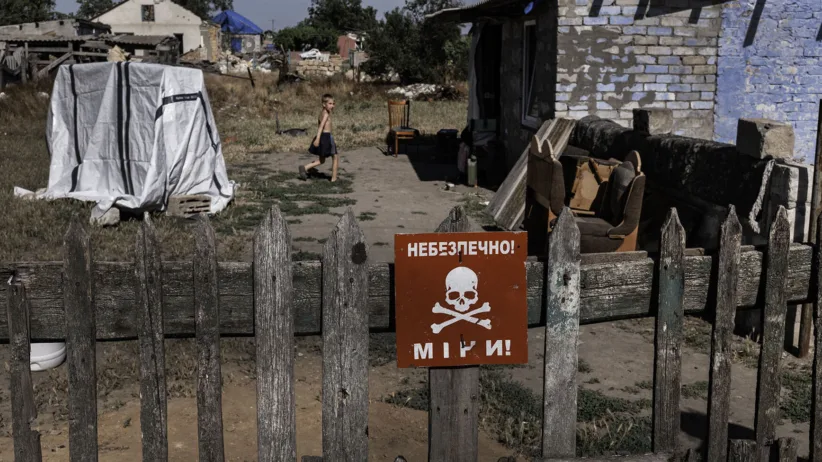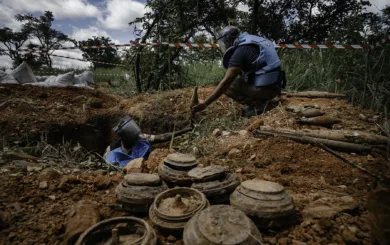Frequently asked questions: The Anti-Personnel Mine Ban Convention
The Anti-Personnel Mine Ban Convention (APMBC) stands as one of the most successful disarmament treaties in history. It has drastically reduced the use of anti-personnel mines, established a global norm against their use, and saved countless lives.

-
Why is the Anti-personnel Mine Ban Convention important?
-
The Anti-personnel Mine Ban Convention (APMBC) was negotiated and adopted in Oslo in 1997 and put an end to the severe humanitarian crisis caused by the widespread use of anti-personnel mines. Since then, 165 states have joined the Convention, and thereby recognized that these weapons cause unacceptable and long-lasting humanitarian harm and have no place in modern warfare. The Convention has created a strong stigma and a global norm against the use of anti-personnel mines and has been a tremendous success in saving countless lives and limbs. According to the Landmine Monitor, the annual number of AP mine casualties has fallen by over 75% from its peak in the late 1990s.
In addition, APMBC is also a landmark treaty which, as the first disarmament treaty ever, explicitly incorporates States Parties’ obligation to provide assistance to victims and their reintegration into society.
-
-
What are anti-personnel mines and how do they differ from anti-vehicle mines?
-
Anti-personnel mines are small explosive devices that are designed to injure or kill people upon stepping on or otherwise activating them. These weapons do not distinguish between soldiers and civilians and can be triggered by very little pressure—just a few kilograms—so even a child stepping on one can set it off. They are easy to hide, they are cheap to make, made of persistent materials and often remain undetonated in the ground for decades after a conflict ends and continue to kill and maim, primarily civilians. Recognizing their severe humanitarian consequences, governments and civil society decided to comprehensively ban these weapons through the APMBC.
Anti-vehicle mines, on the other hand, are much larger and designed to destroy or disable vehicles like tanks and armored trucks. They require a lot more pressure to detonate—usually 100 kilograms or more—so a person walking over one typically won’t trigger it. These mines are not banned under the APMBC, but their use is regulated under international law to prevent unnecessary harm to civilians. As anti-vehicle mines cannot distinguish between military and civilian vehicles, they have a history of causing civilian casualties and obstructing the delivery of humanitarian aid. For these reasons, NPA believes that anti-vehicle mines should be banned on the same terms as anti-personnel mines.
If you want to learn more, read NPA’s Weapons Policy here.
-
-
Has there been any technological development of AP mines that make them safer to use?
-
No. Since APMBC’s adoption, there have not been any substantial technological developments in AP mines mechanisms. While some states claim that there are “safer” mines with self-deactivating or self-destructing system (sometimes referred to as “smart” or “non-persistent” mines), these mechanisms are not foolproof and there is no credible evidence showing that they are more reliable than other AP mines. So even such types of AP mines can still pose an immediate threat to civilians and cause unacceptable harm. Exactly for this reason, the APMBC comprehensively bans all types of victim-activated devices. There is no such thing as a "smart" anti-personnel mine.
-
-
How significant has the Convention been in reducing the use and consequences of AP mines globally?
-
The APMBC is the most successful disarmament treaty in history. Since its adoption, the world has seen a significant decrease in the production, stockpiling, and use of anti-personnel mines and the number of new AP mine casualties has dropped dramatically. According to the Landmine Monitor, the annual number of AP mine casualties has fallen by over 75% from its peak in the late 1990s.
For example, to date, millions of mines have been removed and destroyed in contaminated areas worldwide; over 55 million stockpiled anti-personnel mines have been destroyed; many countries have successfully cleared large areas of contaminated land and over 30 of them have been declared mine-free; the number of countries producing AP mines has decreased from over 50 to fewer than 10; thousands of mine victims have been provided assistance for their care, rehabilitation and reintegration.
However, despite this progress, much work remains to be done. At least 58 countries and other areas are still contaminated by AP mines. In 2023, 84% of the recorded AP mine victims were civilians, with 37% of them being children. This only underscores the continued relevance and importance of the Convention, as well as the urgent need to reinforce and uphold its commitments.
-
-
What is NPA’s view on Poland, Finland and the Baltic states that are now considering or already started a process to withdraw from the Convention? How does NPA assess their justification regarding the increased security threat from Russia?
-
While the security concerns of these countries are understandable, anti-personnel mines have negligible military value in defending against an enemy. As concluded in the ICRC Study, the limited military utility is by far outweighed by the devastating humanitarian consequences of their use in conflicts. In today’s world it is even more obvious that security and border defense cannot be provided by outdated, Cold-war era weapons such as AP mines. Today's technological advancements in surveillance, drones, precision weapons and other systems make anti-personnel mines obsolete. Investing in anti-personnel mines as part of defense strategy is therefore a waste of time and resources, ultimately weakening a country’s defense, rather than enhancing it.
As European countries strengthen their defense, the choice of weapons matters. No context can justify the use of weapons that primarily kill and maim civilians. Indiscriminate weapons with documented unacceptable humanitarian consequences have no place in any defense doctrines. The reinforcement of European countries’ defense is both important and urgent, but it must be done in accordance with international law and humanitarian principles and adequately serve their defense purposes.
-
-
The five European countries stated that should they use AP mines, they will “use them responsibly” and that they would still adhere to IHL obligations on the protection of civilians - can this truly be ensured?
-
While such formal claims by the respective government officials may sound reassuring to many, the reality on the ground is far more complex and tells us quite the opposite. Evidence shows that AP mines cannot be used "responsibly", especially when deployed in the heat of battle. As the ICRC Study found, the very nature of these weapons, which cannot distinguish between combatants and civilians, makes compliance with the rules of IHL almost impossible. History has clearly proven that use of AP mines in a manner consistent with international law has rarely happened in practice - even if used by well-trained military forces.
Arguments about maintaining proper marking systems and thorough documentation of minefields are meaningless when confronted with the realities of today’s world – more frequent flash floods, natural disasters or even attacks on dams in conflicts (as we witnessed with Kakhovka dam in Ukraine). These unpredictable events can cause displacement of mines, which leads to previously safe areas becoming dangerous without warning. In addition, since such maps are not available to the public, entering a potentially contaminated area becomes a life-threatening gamble. These facts undermine any mapping or marking efforts and dramatically increase the risks to civilians. When looking at evidence instead of theoretical concepts, the promise of "responsible" use of landmines becomes practically impossible to uphold.
-
-
Has there ever been a case of a State Party withdrawing from the Convention in the past?
-
As of April 2025, the Convention has not faced a formal withdrawal since its adoption in 1997. Pulling out of an international treaty designed to protect civilians and reduce the devastating effects of war would not only be unprecedented but also deeply alarming and despicable. International humanitarian law is not a cherry-picking exercise – its rules apply exactly in times of conflict and are to be upheld to protect human life, not to be abandoned when tensions rise.
Moreover, we cannot forget to look at this issue in a wider context. The APMBC is part of the rules-based world order that was built up especially after World War II. Upholding international law and maintaining this rules-based order is particularly important for small and medium-sized countries, as it helps to protect their national interests.
-
-
What are the concrete risks to civilians if anti-personnel mines are once again used on a larger scale?
-
The Convention was adopted to ensure that the world would never go back to the dire humanitarian crisis the widespread use of AP mines caused. In the 1990s, it was estimated that 20,000–26,000 people were killed or injured by AP mines annually, most of them civilians.
Increased use of anti-personnel mines would have severe and long-lasting humanitarian consequences as well as enormous financial costs. As explained, these weapons do not distinguish between civilians and combatants and once laid, they remain a deadly threat for local populations for decades. Sadly, children often fall victim to these terrible devices while playing in the fields or when mistaking them for a toy.
Besides the immediate risks to life, contamination by anti-personnel mines fuels displacement, blocks access to essential humanitarian response, blocks access to water sources, schools, or hospitals, and has long-term negative social and economic consequences. They contribute, for example, to making agricultural land unusable and hinder effective reconstruction and development after conflict. The fear of anti-personnel mines alone can cause people to be too afraid to return home, with consequences for local employment and healthcare services, among other things.
-
-
What do experiences from other countries where anti-personnel mines have been used show?
-
Experiences from heavily mine-affected countries such as Cambodia, Afghanistan, or Angola demonstrate the long-lasting devastation caused by AP mines. Even several decades after the conflicts ended, the AP mines continue to pose a major risk to the local communities. For example, in Cambodia, where NPA has been working since 1992, the number of people killed or injured by AP mines reached thousands per year in the 1990s. In 2023, this number counted less than a hundred, underlining the importance of the Convention and ongoing mine clearance operations.
Today, the use of AP mines in the conflict in Ukraine offers another tragic example, turning the country into one of the most heavily mined countries in the world. AP mines add to the already devastating humanitarian crisis by maiming and claiming the lives of civilians, including children. In Syria, over 600 people, including children, have been killed or injured by landmines and other explosive ordnance since December 2024. This marks a significant rise in the monthly number of casualties, likely linked to the increased movement of displaced people returning home after the fall of Assad’s regime.
These experiences are the foundation of the APMBC. It was the lessons from history about the grave humanitarian consequences, along with the understanding that AP mines have negligible military utility, that pushed governments and civil society to fight for a comprehensive, global ban.
-
A message from Norwegian People's Aid to countries that are intending to withdraw from the Convention
The Norwegian People's Aid's message to countries considering withdrawal is simple: Look at the facts and evidence from the ground. Anti-personnel mines do not stop invasions and do not win wars — what they actually do is that they terrorize, kill and injure civilians for generations to come. They have been banned in more than 80% of countries in the world exactly for these reasons.
Withdrawing from the Convention would endanger your own civilians more than it would deter, delay or stop any external threats. Security built on weapons that are not proven to have any real military utility, kill indiscriminately and harm primarily civilians is simply irresponsible.
Now, more than ever, States Parties must stand firm and strengthen the norm and stigma against the AP mines and make it clear that protecting human life and dignity should never be sacrificed for short-term mistaken security considerations.
Learn more

Interventions to prevent withdrawals from the Mine Ban Treaty

Norwegian People's Aid strongly condemns the joint intention of the Baltic states and Poland to withdraw from the Anti-Personnel Mine Ban Convention

